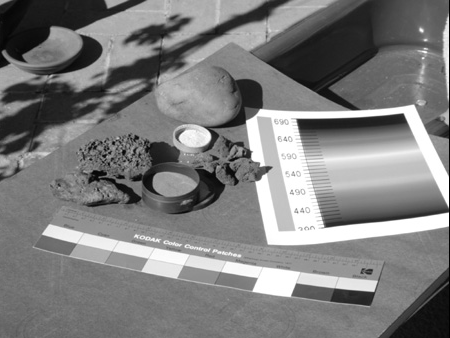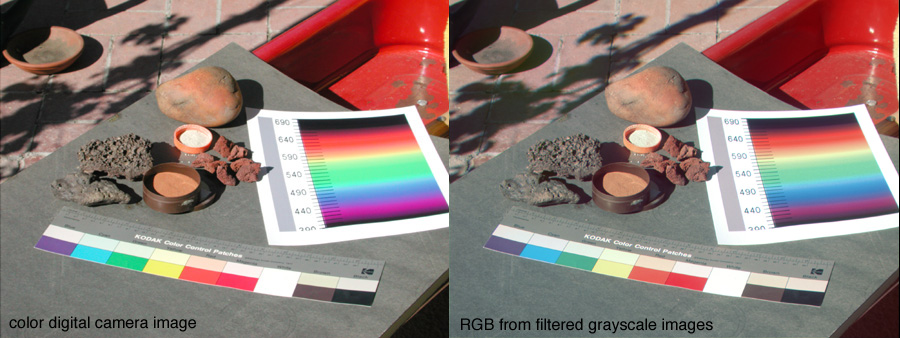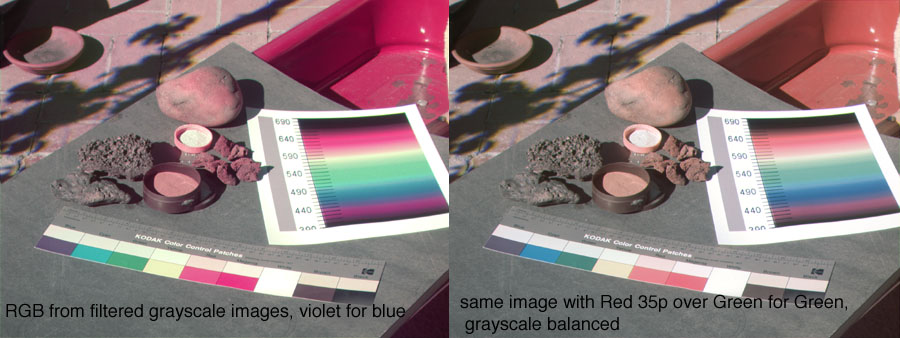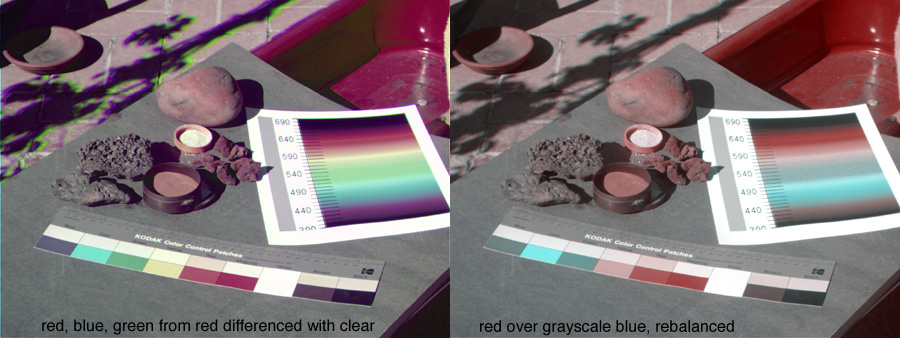 Color pictures and color filters
Color pictures and color filters Color pictures and color filters
Color pictures and color filtersI have attempted some color imaging experiments using the Nikon Coolpix 990 digital camera in color and gray scale modes. The gray scale exposures were made through various color filters from a 'filter sample book' made by the Roscolux company, left over from my film effects days. The transmission curves of the red, green, blue and violet filters I used are shown at left. Later I will repeat this experiment using filters with narrower band pass for each color which will probably provide more distinctive results of the kind which are indicated here.. Below is the unfiltered grayscale image

Red, Green and Blue
Below is a digital image of items chosen for color reference. The rock samples in front of the rounded rust coated stone include: a pair of spongy looking lava samples from Amboy Crater on the left, a brown plastic can containing dust from Monument Valley, an orange plastic bottle cap filled with bright 'ivory tan' colored Black Rock Desert playa dust and small chunks of common landscaping lava. The background includes part of a fire engine red 'Radio Flyer' wagon and some brick and ceramic surfaces. The two color references are a Kodak color control chart and a glossy print of a spectrum I drew in Photoshop (and used above) based primarily on my observations looking through a spectrometer using sunlight reflected from a large white surface at noon matched to the numerical scale. The various images were made about 2:40 PM on October 14 in clear atmospheric conditions, so the light would be reddened a little from noon summer conditions but the overall impression is still close to neutral. The gray portion of the Kodak chart was used to provide overall color balance using the Photoshop 'curves' gray point.
The left image below is a gray balanced but otherwise unprocessed color digital image. The right picture is an RGB composite made with gray scale images taken through Red, Green and Blue filters of the transmission characteristics shown above. The 'leakage' of the filters used compromises the accuracy of the results but the overall color quality using this relatively sloppy technique appears surprisingly good. The magenta and red colors are not as well distinguished in the RGB composite as with the color imager, and reflection of the blue sky on the shiny wagon paint, and the yellow and purple colors in general show up better in the color image than in the RGB composite version. The color fidelity of the RGB composite often appears strikingly good in detailed examination and the sharpness on the original 2K image is noticeably improved over that of the color CCD image.

Red, Green and Violet
Some spacecraft use filters for color images other than the Red, Green and Blue (RGB) standards for color reproduction. The shorter wavelength record is sometimes made in the violet part of the spectrum instead of the blue.
The left image substitutes a violet filtered image for the blue filtered gray scale image. The redder parts of the scene assume a magenta hue and the yellow hues are subdued.
The right image used a violet filtered image influenced by the content of another of the available channels. In Photoshop the red channel gray scale image was 'stacked' atop the green filtered gray scale image at 35 percent opacity. This new gray scale image used as the green channel brought back some of the more saturated red, but at the expense of the green. Both images were 'gray balanced' using the Kodak chart background. A purple cast to both images suggests the qualifications one might have with apparent colors obtained using such filters.

Red, Blue and faked Green
A common variation in spacecraft images appearing in this cost constrained era are Red and Blue with a Green channel created by merging the existing pair. This color combination loses any detection of anything green in the view, however the likely range of surface colors to be observed, as well as the rocks in this view, are of the range of color which falls nicely within the wavelengths used and are shown with surprising color accuracy. Mars is reasonably well suited for such 'color' imaging although yellow color variations will be suppressed. Of course any green rock types, if they should by chance exist, will be misrepresented entirely.
The left image uses the red and blue channels stacked 50/50 to create the 'green' channel.
The right image has the 'green' channel further treated by using a red channel at 30 percent opacity in 'difference' mode on top, the result then being flattened and 'curved' to make the border of the spectrum print white and the result, which reduces the green component in the reddest regions, looks a bit more natural. The rock and soil surfaces seem particularly well represented.

Some odd color variations
In the left image red, blue and clear exposures were made. By placing the red exposure over the clear image in 'difference' mode the red light is largely 'subtracted' from the image and made into a surprisingly decent 'green' channel although the reds tend towards magenta. Note the mis-registration of the shadows at the upper left caused by the movement of the Sun between the grayscale image exposures.
The right image is the most curious of all, and is related to the peculiar 'color reconstruction' effect discovered by Edwin Land in 1959 when examining multiple aligned projections made with different filters. A red exposure tinted red and placed over a blue filter exposed gray scale image will show a surprisingly well defined range of apparant color variation, although all of that image is tinted red to varying degrees. Using the gray background of the color chart to 'snap' the overall balance back toward the 'middle' using the Photoshop 'curves' tool reveals more clearly the perceived 'color range' somehow provided by even such minimal color information.
